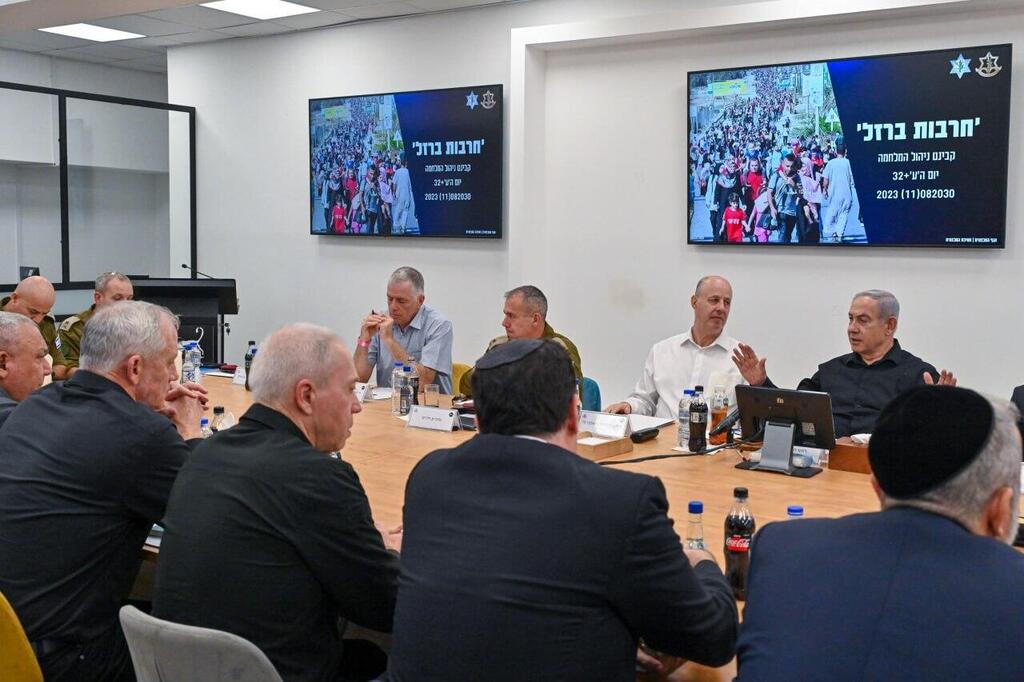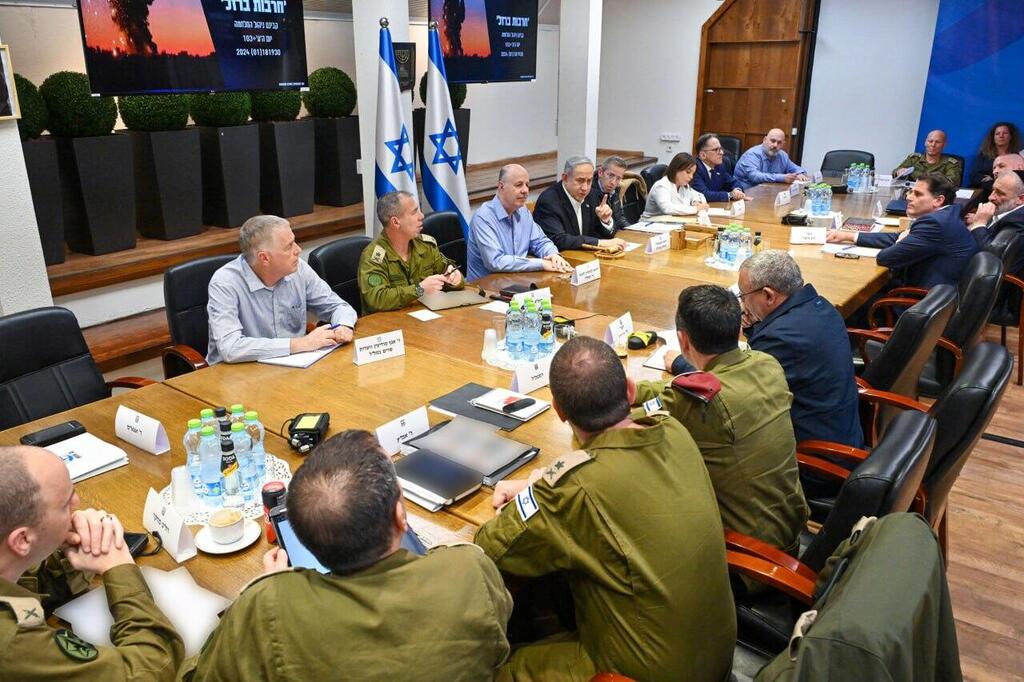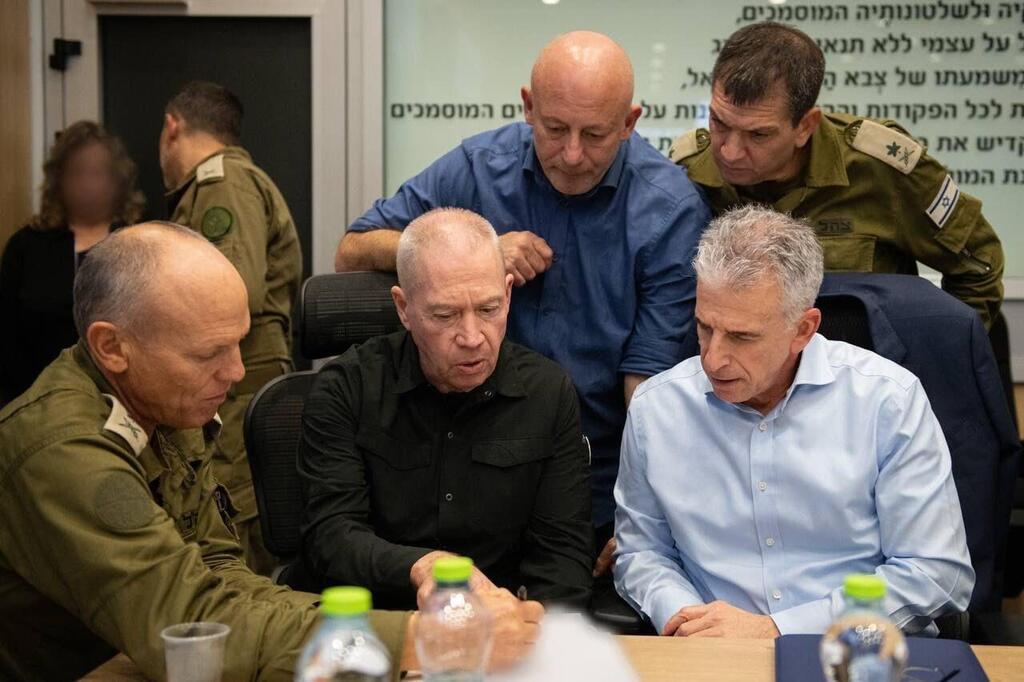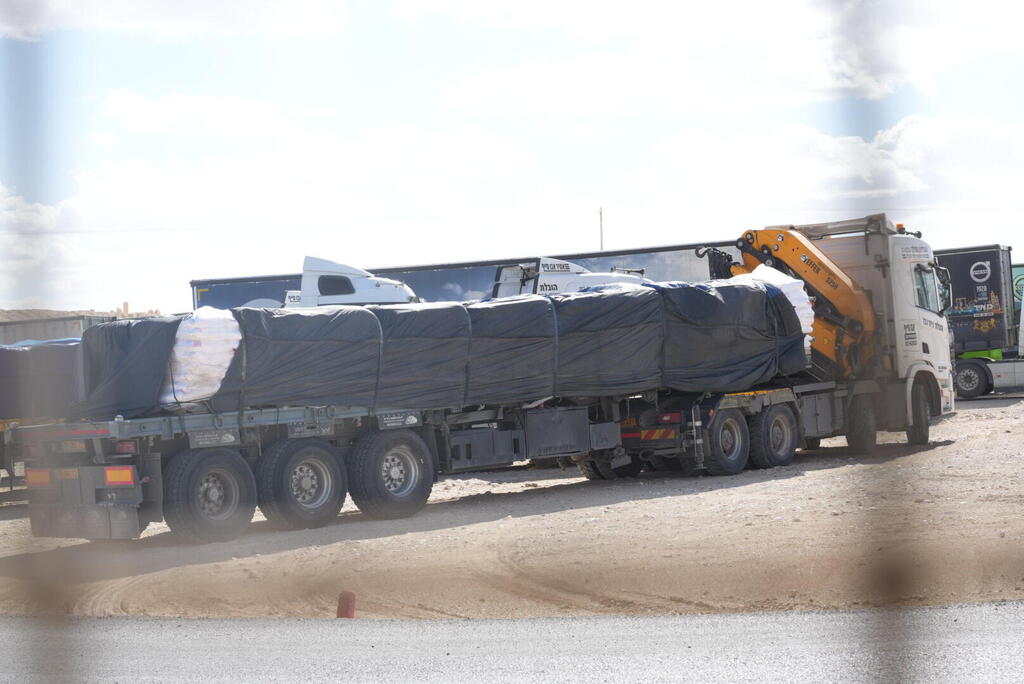Security officials who often pass by the "Pit" in the IDF headquarters in Tel Aviv during Cabinet discussions almost always wonder which forum is being convened there, and for a reason – if it is the narrow War Cabinet, then most likely critical issues are being discussed, and if it is the extended State Security Cabinet, it is no more than a show for the media.
More stories:
What was once the country's security nerve center has become a political battleground. There were endless leaks to the media, confrontations between the attendees and repeated attacks on the IDF chief of staff and IDF officers. No wonder then that a narrow War Cabinet was formed. This is how the "Holy of Holies" of war is conducted.
8 View gallery
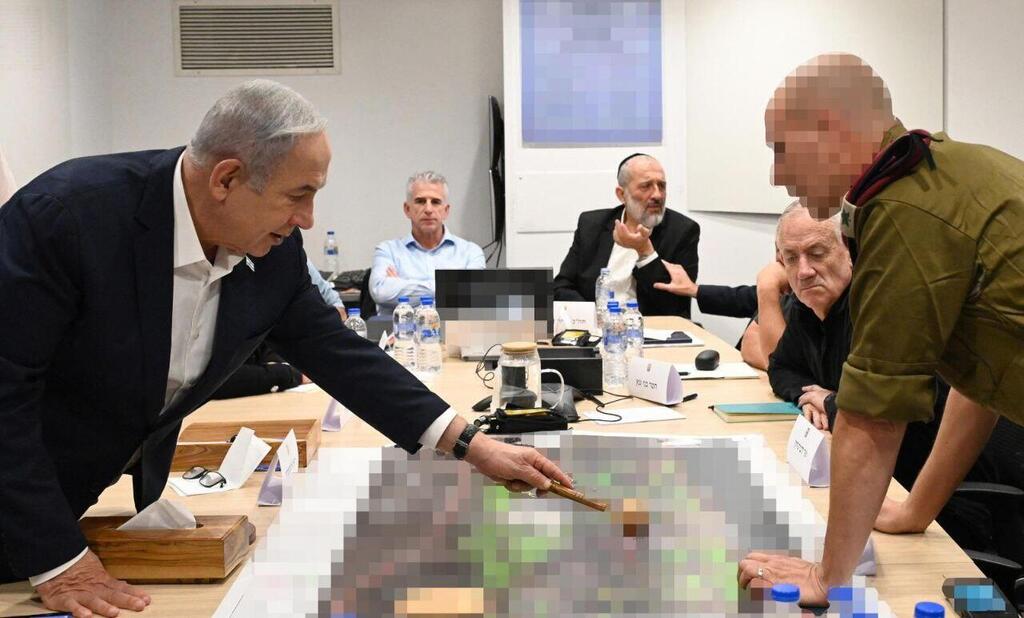

Prime Minister Benjamin Netanyahu in a situation assessment meeting with members of the War Cabinet, in IDF HQ, Tel Aviv
(Photo: GPO)
From 'Kitchen Cabinet' to War Cabinet
The War Cabinet is not a new concept. It was preceded by the "Kitchen Cabinet" (after former Prime Minister Golda Meir's custom of calling such consultations at her home) and other narrow forums where the governments of Israel conducted the wars in the past.
The Winograd Commission report which investigated the Second Lebanon War included a recommendation that a “War Cabinet” be established during wartime; this recommendation was reinforced in 2016 by a professional commission headed by the then-National Security Advisor Yaakov Amidror.
Then-Education Minister Naftali Bennett demanded that Prime Minister Benjamin Netanyahu appoint a military secretary to the Security Cabinet. Following the demand, a commission headed by Amidror was established to examine the activities of the Cabinet and recommended the establishment of a "War Cabinet."
The rationale for the recommendation was that the Security Cabinet was quite a large body comprising too many people. Along with the senior security officers, it also includes 11-15 ministers.
decision-making should be confined to a smaller group within the guidelines set by the larger Security Cabinet. Essentially, the War Cabinet is tasked with leading and managing the war.
The current War Cabinet was formed on October 11 following a coalition agreement signed between the ruling Likud Party and the opposition's National Unity Party. The Prime Minister's Office decided to stick to the definitions of the Amidror Commission.
The War Cabinet comprises only three voting members: Prime Minister Netanyahu, Defense Minister Yoav Gallant and Minister Benny Gantz. Additionally, three observers participate: National Unity's Minister Gadi Eisenkot, Likud's Minister for Strategic Affairs Ron Dermer and Shas chairman Aryeh Deri, who attends most meetings.
In addition to elected officials, the War Cabinet also includes IDF Chief of Staff Lt. Gen. Herzi Halevi, Mossad Director David Barnea and Shin Bet Director Ronen Bar. Usually, the IDF generals who manage the war also join the discussions - Strategy Division head Major General Eliezer Toledano, Operations Division chief Major General Oded Basyuk, Military Intelligence commander Aharon Haliva and the military liaison to the Palestinian Major General Ghassan Alian. Also present at all the discussions are National Security Adviser Tzachi Hanegbi, Netanyahu's military secretary Major General Avi Gil, Cabinet Secretary Yossi Fuchs and the prime minister's chief of staff Tzachi Braverman.
According to the coalition agreement, the War Cabinet is supposed to meet every 48 hours, but it usually meets two or three times a week, in agreement with Gantz. The discussions are usually held in the Kirya base in Tel Aviv, in the "Pit" of the Operations Division or in the Prime Minister's Office. From time to time, given schedule constraints, the discussions are held in the Security Cabinet room.
Unlike the larger Cabinet, the discussions held in the War Cabinet are shorter since there are fewer officials who want to speak and there are fewer participants in general, so the discussion is shorter and more to the point. The ambit of the War Cabinet is also narrower than that of the extended one. About 15 people make up the skeletal forum of the War Cabinet, compared to 25 in the skeletal forum of the larger Cabinet, which sometimes numbers 50 people.
Sharp disagreements and media leaks
The discussions within the War Cabinet involve numerous visual aids, such as slides and aerial photographs, to show the deployment of the forces, videos of significant events from the fighting in the various sectors - including airstrikes and achievements in underground fighting.
Not all the materials presented to the members of the War Cabinet are classified, but there is no doubt that those sitting in the room see things that the public has not been exposed to, and probably will never be exposed to, such as the compilation of raw footage of the October 7 Hamas attacks. Live operations though are shown only in smaller forums.
Sources familiar with the War Cabinet say that it is running well. Naturally, there are disagreements, but they can be regarded as brainstorming. So far, there haven't been many conflicts among its members, maybe because they know that this is the only place where classified information is safe and usually doesn't leak.
"I think that in the 'Holy of Holies' of state security, things are being conducted in a respectable and matter-of-fact manner," said an official who attended all War Cabinet meetings. Unlike the larger forum "for the most part, things don't leak from here."
Those who work closely with Netanyahu say that even his opponents know that in these discussions, he is the most relaxed, contained and calm in the room. It allows everyone to speak and express opposite ideas that sometimes make sense.
"The conversation is flowing, and sometimes Private Aryeh Deri can say something brilliant and useful, no less than one of the IDF major generals sitting in the room"
"The prime minister does not set strict rules. The conversation is flowing, and sometimes Private Aryeh Deri (who has no military experience) can say something brilliant and useful, no less than one of the IDF major generals sitting in the room," described one senior official.
At times, a senior security official may advocate for one approach, while another holds a strongly opposing view. This situation complicates the War Cabinet members' dilemma, as they must make national security decisions while weighing two conflicting perspectives.
For example, there were bitter arguments during discussions on a potential hostage deal. In mid-January, the War Cabinet discussed the impasse in negotiations for the deal. Gantz and Eisenkot believed that Israel should think "outside the box," prioritizing the return of the hostages, even at the cost of stopping the war, and completing the second war goal of destroying Hamas at a later stage.
In one of the few leaked discussions, Eisenkot said, "We need to stop lying to ourselves, show courage and lead to a large deal which will bring home the hostages. Their time is running out and every day that passes endangers their lives. There is no need to continue to march blindly while the hostages are there. This is a critical time to make brave decisions. Otherwise, we have nothing to look for here."
On the other hand, Prime Minister Netanyahu, Defense Minister Gallant and Strategic Affairs Minister Dermer were of the opinion that only military pressure would secure a deal for the release of the hostages, and that Israel should not agree to every deal, and not at any price.
8 View gallery
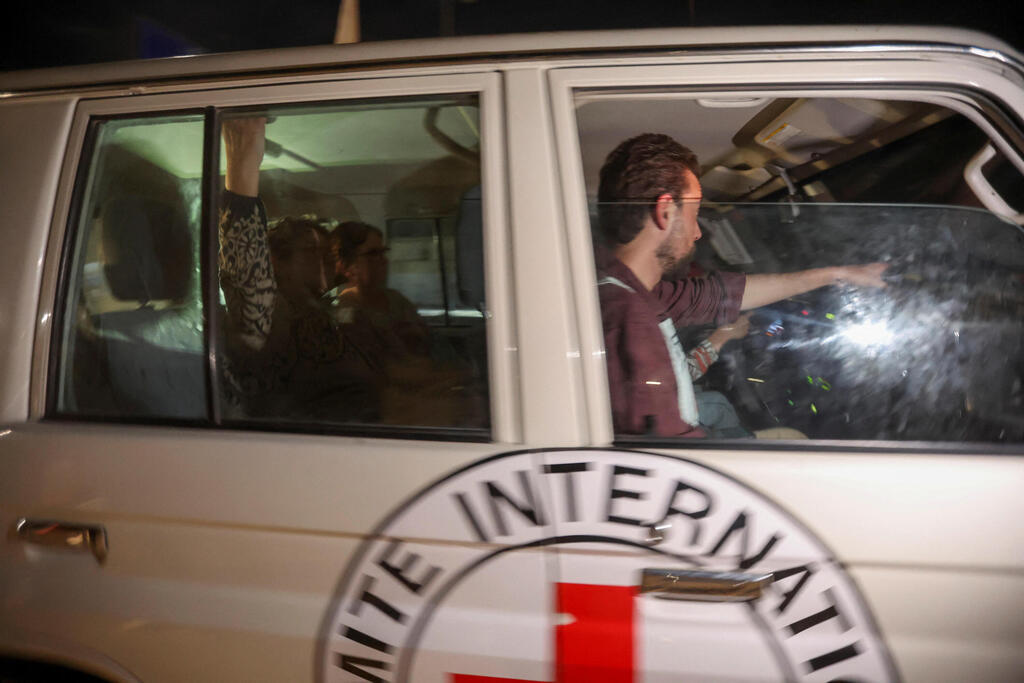

Israeli hostages transported back to Israel by Red Cross in previous hostage deal, in November
(Photo: Reuters / Ibraheem Abu Mustafa)
This dispute was preceded by a sharp confrontation in mid-November between two axes - Gallant, Bar and Halevi on the one hand, who claimed that Israel should not negotiate on the release of hostages and that heavy military pressure should be continued, which would later lead to a deal; and Ron Dermer, Deri, Gantz and Eisenkot on the other hand, backed up by Mossad chief Barnea, who believed that it was right to hold negotiations while fighting because there was a chance for the release of 50 women and children, or even more, according to Dermer.
Netanyahu was eventually convinced and decided in favor of Dermer's axis - and this decision turned out to be surprisingly successful, when the negotiations led by the Mossad director ended in the release of more than 100 hostages.
Short discussions, broad consensus
War Cabinet meetings usually last between two to four hours, unlike the extended Cabinet forums where meetings can last six hours or more. Inside the room itself, one can find soft drinks or coffee and tea, and some snacks at most. Light refreshments will be waiting outside the room - sometimes a sandwich with cheese, omelet or avocado for vegans. Occasionally they order pizza.
The discussions are usually open with updates and security reviews of all elements involved in the various arenas. Whenever the need arises to make a tactical decision, National Security Council representatives present the meeting's agenda, although not every meeting requires decision-making. In fact, the War Cabinet makes very few decisions, less than one decision per meeting on average; as they convene quite frequently, the members are already thoroughly familiar with all the plans and there is no need to make a formal decision at each meeting.
For instance, after discussing issues related to ground operations in Gaza, the War Cabinet didn't require a formal decision, as these matters fall under the defense minister and IDF chief's jurisdiction. Agreement within the War Cabinet effectively gives the green light to proceed.
Sources familiar with the discussions said that the War Cabinet does not look at things only through military eyes. The prime minister, who is not a military general, together with Dermer and Deri, significantly balance the military viewpoint of the generals present in the room. "It could be quite surprising when someone who is considered to be moderate would hold a militant position on a certain issue, and vice versa. People are not fixed there," one source says.
8 View gallery
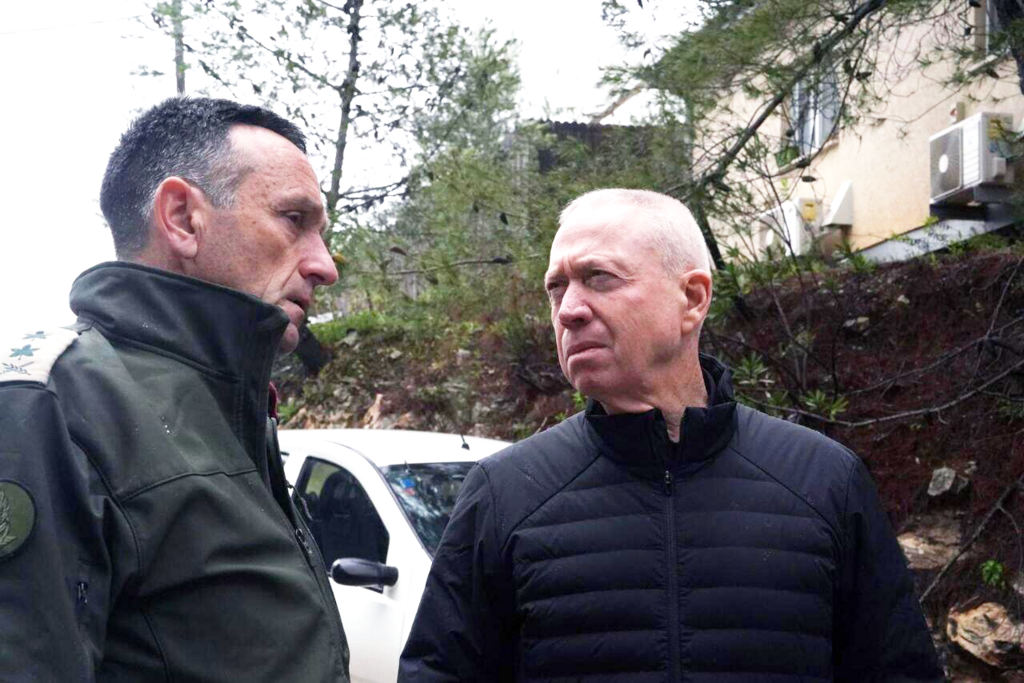

Defense Minister Yoav Gallant and IDF Chief of Staff Lt. Gen. Herzi
(Photo: Defense Ministry)
Sources claim that "Prime Minister Netanyahu manages to steer this ship well despite the political sensitivity among the participants. In most cases, they manage to reach a consensus and a vote is not even required."
In recent months, there have been several unanimous decisions within the War Cabinet, often rendering a vote unnecessary due to its dynamics. However, when Netanyahu, Gallant and Gantz disagree on an issue, a vote is required.
Between two Cabinets
On the face of it, the division of work between the various cabinets should be very clear. "The larger forum does not deal with the tactics of the war, but rather makes principle state decisions. The narrow War Cabinet engages in routine tactical decision-making or the implementation of the directive of the Cabinet decisions," explained an official who was present at all Cabinet meetings. "This does not mean that the decisions made at the tactical level in the War Cabinet become marginal."
For example, the phases of war and ground operations were approved by the extended Cabinet, but the transition between the war phases is a tactical decision that is made in the War Cabinet. Decisions made during ground operations, such as how to operate in the northern or southern part of the Gaza Strip and the layout of forces and divisions, are made by the IDF, and steered by the narrow War Cabinet.
"As in any war, when a battle involves casualties, one can always claim that the tactical decision, such as from which side to enter, has an effect on how many soldiers would fall. Every decision, even at a lower level, has consequences on human life. But decisions that are fateful for the country are made in the larger Cabinet forum", explained a senior who is involved in Cabinet work.
According to the official, "If they had decided, for example, not to go on a ground maneuver and settle for military airstrikes - that would be a significant decision that only the extended Cabinet could make. The decision whether to leave the Strip when the day comes, after the IDF achieves the objectives of the war, will also be made in the extended Cabinet."
In some instances, there were disputes over who was authorized to make a decision, like those involving humanitarian aid. The core decision to offer humanitarian aid to the Strip was made by the extended Cabinet. However, disagreements arose over details such as the number of trucks allowed entry, the extent of aid, the crossing points for these trucks and Israel's position, which fluctuates between enforcing a blockade on Gaza and seeking a hostage deal.
The ministers demanded to bring some of these questions to the decision of the extended Cabinet, as was the case with the fuel and the flour trucks. In another case, the expanded Cabinet was the one that approved the opening of the Kerem Shalom crossing for a security check order to meet the goal of 200 aid trucks per day, as there was a traffic jam at the Rafah crossing.
Theoretically, the War Cabinet was supposed to discuss this initiative by the IDF liaison to the Palestinians, but following demand by ministers, it was decided by the extended Cabinet in a telephone vote.
But this is not the only difference between the cabinets. Government officials feel that the War Cabinet is an "island of sanity," where matters of the war are decided. On the other hand, members of the extended Security Cabinet who oppose the War Cabinet do not deal only with specific questions of authority, but also with the question of who will be included in the smaller Cabinet.
National Security Minister Itamar Ben-Gvir believes that the main problem with the War Cabinet is that it is made up of members of the "conception camp" that brought about the October 7 massacre. Finance Minister Bezalel Smotrich demanded to expand the narrow War Cabinet to include representatives from each coalition party, that is, to add him and Ben-Gvir. Gantz cast a veto, and the request was denied.
8 View gallery
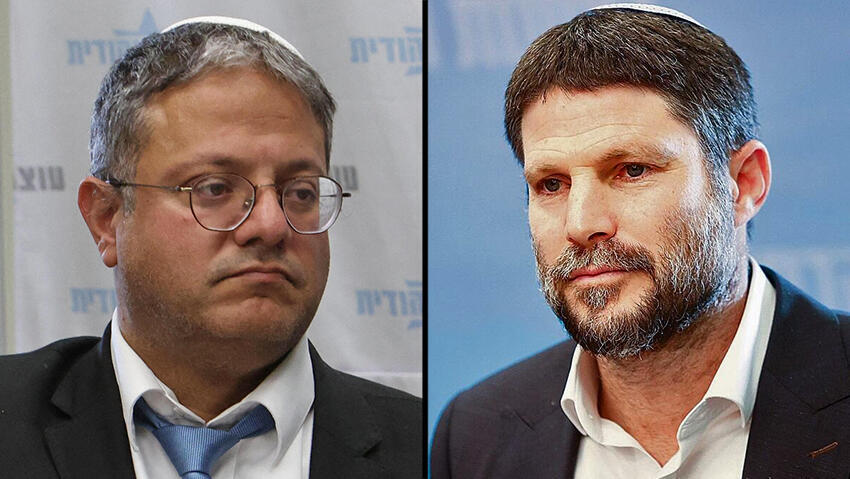

National Security Minister Itamar Ben-Gvir and Finance Minister Bezalel Smotrich
(Photo: Alex Kolomoisky, AFP)
A source close to Netanyahu dismissed the claims. "It is true that only the prime minister, Gantz and Gallant have the right to vote, but there are other people, even if they are observers, and they all have their say. When Dermer, Eisenkot or Aryeh Deri express their opinions – one can see that there are various viewpoints, and definitely not just a military point of view," the source said.
"It is true that if there had been a representation of the Religious Zionist Party and Otzma Yehudit in the War Cabinet, there would have been more differences of opinion because they would have presented more right-wing positions," added the source. "But it is absolutely not true that the War Cabinet holds only one opinion. There is a broad common denominator, and it includes military, international and strategic perspectives that do not involve just military issues."
Following government members' insistence, Netanyahu recently assured ministers that all issues pertaining to the hostage deal would be presented to the extended Security Cabinet. The prime minister might be concerned that Gantz and Eisenkot will pressure him into agreeing to the current proposed hostage deal framework. This situation appears to be a critical test for the War Cabinet.




